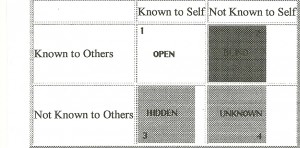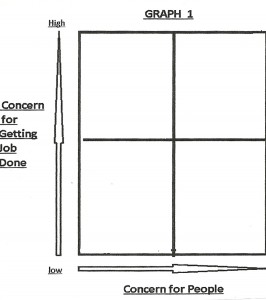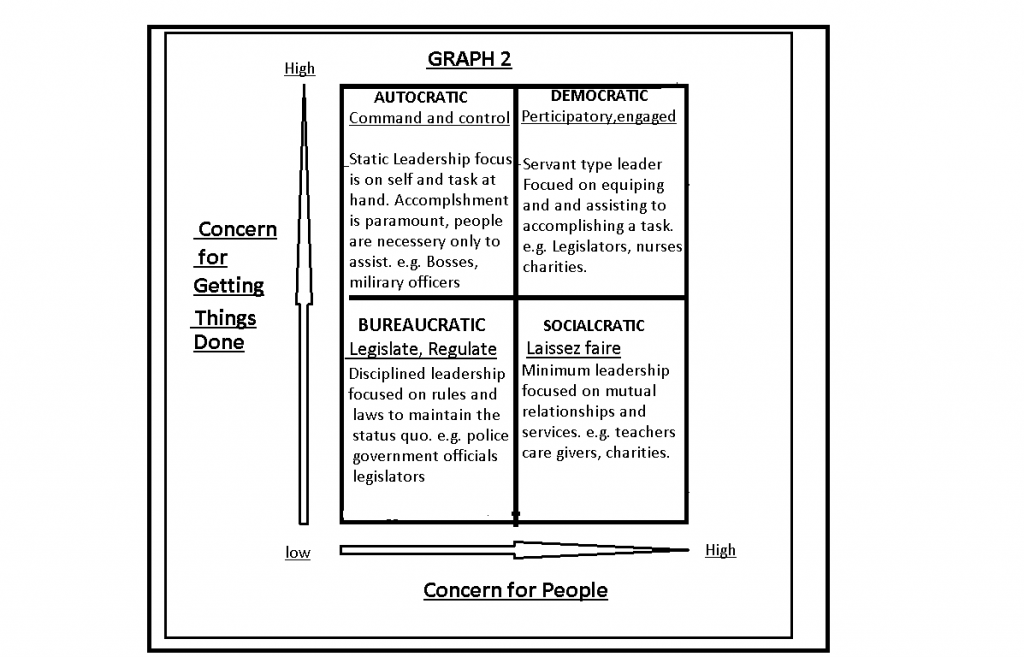UNDERSTANDING YOURSELF and OTHERS

The previous Chapter: ‘Needs Wants and Desires’, discussed things common to all cultures and communities of folks, thing that all servant leaders must keep in mind. Now let’s take a closer look at similarities and differences in individuals. Understanding folks being a key element of servant leadership.
The things we’ll look into are:
.
1. A fun little exercise.
2. Personality – Character – Temperament.
3. Johari’s Window (a model for describing interaction).
.
How important is it to understand the real you, or more importantly to know a spouse, neighbor, co-worker or your own children? Not very much you may say. Well, let me ask you a question then. Have you ever had anyone say to you “you just don’t understand me”? That particular question is usually asked in the heat of a strong disagreement. Your mental (but silent) response was probably something similar to this, “of course I do, you’re not anything like me”. Half of that response is correct, they are not like you, and that’s the good part. The “of course I do” is what was wrong. You just did not truly understand them! Your focus was on the issue and yourself.
You’ve heard that opposites attract? I can assure you that that is true of people. For example, my wife and I are complete opposites, and our children are opposite from each other and from each of us. Yet we work well together as a family. All it takes is your understanding, insight, and a continuous effort.
Before getting too deeply into this unit, here’s a fun little exercise you can do, which may demonstrate the importance of understanding yourself and others.
A Fun little exercise.
Take a Look below at Graph # 1. This graph/diagram relates one’s motivation for getting things done, versus one’s concern for others. The vertical axis ranks from low to high your motivation for getting things done. The horizontal axis ranks from left to right ranks your concern for others. Here’s what you do. 1. First of all be honest with yourself in your ranking! Don’t rate yourself where you would like to be or where folks think you are, just your true nature. 2. Now move to the right along the horizontal axis to where you think your true ‘concern for others’ lies. 3. Than move up form that point vertically to where you think your true ‘motivation for getting things done’ lies. 4. Mark that point on the graph.
Ok, now give Graph 1 to someone who is a co-worker, spouse, close friend, or some intimate acquaintance, but don’t show them where your point is on the graph. Have them also pick a point on Graph 1, which they honestly think best fits you. (Remember low to high on the vertical, and left to right on the horizontal.) How did the two points match up? Nine times out of ten the two points were in the same quadrant, but that’s about as close as they get. Not to worry, it just shows the difference between what you think about yourself and the way others see you. Discuss with the person why they rated you way they did. Don’t disagree or try to influence them Just Listen to what they have to say. Being a good listener is the first step in understanding yourself.
Now lets take a look at graph 2. Locate in the same quadrant on graph 2 the same place you selected on graph 1. Each quadrant depicts a different management style. i.e. Autocrat, bureaucrat, democrat, and what I named a socialcrat.
The data in the four quadrants of graph 2 is general and not meant to be absolute. However, it can be used as a guide for helping you understand yourself and evaluating your vocation. For example, if your point falls within the quadrant for an autocrat and your current job is in the area of social work you’re probably frustrated and unhappy.
Here’s a little ditty which may help you recall the extreme leadership characteristics outlined by the four different quadrants.
A sailor fell overboard.
The autocratic shouted “man the life boats, get a move on, hurry men, pull on those oars”.
The bureaucrat said “not so fast, first check the regulations for safely using the life boat”.
The democrat says “let’s form a team. That way we will be more efficient and row better together”.
The social-crat tosses a life ring out and says,“Here help yourself “.
Hope you enjoyed this little exercise, and that it was of value in beginning to help you understand yourself. You see, if you don’t have yourself accurately and honestly appraised, you will have a difficult time appraising anyone else. Understanding yourself and others is of paramount importance, because it allows you to see others as unique individuals with both strengths and weaknesses. You as a leader want to maximize others strengths and minimize their weaknesses. Some folks use athletics or sports to show the importance of working together. However, much of what is touted as teamwork is really just individual performers put together and called a team.
There is one sport however, that must have true teamwork or it is “dead in the water”. This sport is the only one I know of where the team is setting down and looking backwards. What kind of sport would that be? Ever watch an eight man/women rowing crew compete? That’s pure working together (team work). You see each member of the crew has their eyes and ears fixed on the coxswain. (This is the leader in the stern, looking forward, steering and counting cadence). All the crew members must be in absolute sync. The strongest member can’t start pulling harder, and the weakest can’t slack off. Likewise, one can’t dig their ore deeper in the water than another crew member. Should any crew member try to speed up, slow down or dig deeper, the cadence is interrupted. The craft slows down, and starts to run off line. The race is lost! Chris Thorsness was Alaska’s first Olympic gold medal winner. The sport she participated in wasn’t skiing, sledding, skating, curling or any other winter sport; it was for rowing. Now, let’s get down to the business of looking deeper into ‘Understanding Yourself and Others’.
We’ll next examine the difference between: PERSONALITY– CHARACTER – TEMPERAMENT
Personality: “Boy does he/she have a great personality” Have you ever used that expression? Sure you have. What does that mean? Note first, that personality is that which you observe about the person. You see, it is possible and highly probable that someone else may observe something quite differently about that same person. Why? Because personality is the outward expression the individual chooses to display. A personality can and does change. You probably noticed in your own life how your personality changed along with your circumstances and age. Plus, you’ve noticed how much effort and vigilance it takes to maintain a particular face (personality) to show the world. Remember the adage “don’t trust first impressions”. That’s because a personality doesn’t reveal much about the person, it reveals only what they choose to show. That’s why in job interviews, the questions asked help dig a little deeper behind the face you show. One is usually better off to display and discuss your character in an interview.
Character: “Man, what a character he/she is”. Ever use that expression? Sure you have. Again, what does it mean? Character is more than the face we choose to show (personality). Character has more to do with the mental and moral qualities which distinguish us. Things like honesty, levity, integrity, uprightness, or disposition. Character has to do with the hidden person of the heart, the whole/real you. One’s character consists of your inborn person along with training and life experiences, commonly referred to as your soul. Your character does and will change as one learns and matures.
Dr. Morris Massey (
www.morrismassey.com) was honored with the W.M. McFeely award for his “Significant contributions to the field of management and human relations”. Dr. Massey’s lectures discuss value programming of individuals based on their formative years. The series is titled
“What you are is what you were when”. His premise is that individuals think and act in light of the norms and culture gained in their formative years. For example, those born in the decade of the 1940’s carry and exhibit the cultural of that decade with them through adult years. The National and culture attitude of the 40’s decade was WIN. The whole nation was focused on winning the “second world war”. He points out the only way you modify value programming (character) is by experiencing a “significant emotional event”. One comment about Dr. Massey’s lectures, “He talked faster than I could listen”. Thus, I missed an awful lot. So, if you can get a copy of his lecture’s, then fasten your seat belt and enjoy.
Temperament: Temperament consists of traits you are born with and which subconsciously affect one’s behavior. We are all different and no amount of training or coercion will change the real you. When in a crisis mode, your temperament will always dominate. David, an ancient Israeli king, said in one of his psalms “you are fearfully and wonderfully made”. Meaning there is no other person exactly like you.
That even applies to identical twins. Here’s my real life observation of that fact. My wife and I had the privilege of periodically watching over eight year old identical twin girls. For the longest time I couldn’t tell them apart, especially at a distance. Gradually, the differences were noticeable, particularly in how they approached other people and things. One seemed to be more gregarious than her sister. Her sister on the other hand was more intuitive and curious. After a while, even the way they carried themselves became a distinguishing trait. However, from a distance, recognition was difficult. Engage them in a conversation however, and the differences were obvious. All this goes to say is that they displayed identical appearance, culture and characteristics, but different temperaments.
There are no good or bad temperaments, nor is there any reason to try and change them, because temperments are inborn, not learned or developed.
The Pygmalion desire (named after a Greek god) is to try and make all those near us just like us. A leader doesn’t do that! Leaders try to understand others and not try to make them into themselves. Trying to change someone’s temperament won’t work, you’ll both be frustrated. You will find that when confronted with a crisis or difficult situation your temperament will always prevail over personality or character.
Dr. Glasser, makes a very interesting statement in his book Control Theory Management. He states, “You cannot make anyone do what he or she does not want to do. You can only teach them a better way and encourage them to try it.” This is probably very true. He goes on to explain that if what you are trying to teach works, there is a chance it will be adopted and continue. However, what you would be doing is changing the character and not the temperament. I’ve found the method by which teaching is accomplished to be very important. Rote memory is short lived and usually lasts only long enough to get a student through the next exam. Folks need to have practical examples or applications before it is fully inculcated into their manners and norms of doing things, their character. Many folks have an aversion to change unless a positive, personal benefit in a saving of time or money can be demonstrated. That’s what makes leading, teaching or mentoring a challenge.
Wait a minute! Now you’re saying people can and do change. You said in the Chapter: ‘Needs Wants and Desires’ that “Peoples is Peoples”. True, but that discussion was talking about groups and communities of folks. Groups and communities take on a norm or common identity. This discussion focuses more on the individual. Communities don’t have tempermanents. You may not be able to change ones inborn temperament, but surely one can learn to strengthen their positives and suppress their negatives until they are under a crisis. Suppress sure, but not change.
Temperament Classifications:
The concept of categorizing or classifying people into like groups (temperaments) is not new. The ancient Greek philosopher/physician, Hippocrates, in trying to account for basic human behaviors settled on four distinct temperament types. His fame wasn’t in the field of behavioral sciences, but in the field we now call medicine. Yep, his oath was “Do no harm”, The Hippocratic Oath. This is same one taken today by medical doctors. Hippocrates named four temperament types after bodily fluids (so the story goes). They are Sanguine, Choleric, Melancholy and Phlegmatic. These terms are still used by psychologist and in other medical professions.
Work by Isabel Meyers and Katharine Briggs, in the mid 1950’s revived some of Hippocrates classifications and developed their now famous Myers-Briggs Type Indicator. The sixteen “Types” developed by Myers-Briggs, arrange themselves nicely into Hippocrates’ four temperament classifications. I highly recommend you take the ‘Myers-Briggs Type Indicator test’. This can be accomplished by seeing a counselor or psychologist who is authorized to administer the test. It’s worthwhile for a full understanding of yourself and others. Following are some general strengths and weaknesses of each temperament type named by Hippocrates. See if you can find yourself in any of the classifications. Again have someone that knows you very well see if they can ‘pick you out’. Then, discuss the strengths and weaknesses.
.Sanguine
Strengths: Optimistic, Friendly, Compassionate, Easy going.
Weaknesses: Restless, Weak-willed, Egotistical, not stable.
Choleric
Strengths: Strong will power, Practical, Optimistic, Opportunist
Weaknesses: Hot tempered, Cruel, Imperious, Self sufficient.
Melancholy
Strengths: Sensitive, Perfectionist, Analytical, Self sacrificing.
Weaknesses: Self centered, Pessimistic, Moody, Vengeful.
Phlegmatic
Strengths: Witty, Dependable, Practical, Efficient.
Weaknesses: Slow, Stubborn, Indecisive, they tease.
.
Books are very expensive, so I don’t recommend many. However, one book you may want to look at or acquire, is PLEASE UNDERSTAND ME: CHARACTER & TEMPERAMENT TYPES, by David Keirsey and Marilyn Bates. (The ISBN number is 0-9606954-0-0.)
About twenty years ago its cost was twelve dollars. I’ve no idea of what it costs now. This little book includes a temperament sorter test, answer sheet, and scoring directions. A really nice thing is the appendix, where a portrait of the different “preference types” is given. I’ve found it to be a handy reference. You’ll really learn a lot and have a bunch of fun with this little book. Especially after you have taken their temperament sorter, and find your portrait description. The following summaries and discussions of temperament are taken from the book by Keirsey- Bates. They discuss four pairs of preferences which a person displays. These four pairs are Extraversion/Introversion, Sensation/intuition, Thinking/Feeling, Perceiving/Judging. Please note that a person is not purely one or the other of any type. For example, one can be to some degree a little of a couple of them. A detailed description is covered in the book. Below is just a brief summary.
Extraversion (E) vs. Introversion (I)
The person who chooses people as a source of energy is probably an extrovert (E), while the person who prefers
solitude for the recovery of energy is an introvert(I).
Intuition (N) vs. Sensation (S)
The person having a natural preference for intuition(N) probably describe himself as innovative. While The person who has a natural preference for sensation(S) probably describes himself first as practical.
Thinking (T) vs. Feeling (F)
Persons who choose the impersonal basis when making a choice are the thinking (T) type. Persons who choose the personal basis are called feeling (F).
Judging (J) vs. Perceiving (P)
Persons choosing closure over open options are likely to be judging (J) types. Persons preferring to keep things open and fluid are probably the perceiving (P) types.
Once again, upon taking a temperament sorter test, have someone that really knows you well read your portrait. Usually, their comment is something like this “that’s a dead ringer of you”, much to your surprise, because you thought they’re wrong or just partly right. Really?! You just learned a little more about the real you. Keep in mind though there are no pure fits to any of the preference types. This is all explained in the book. My preference type according to Myers-Briggs and Keirsey- Bates comes out to be ENTP. Other similar temperament sorters use analogies for the various types. My type is commonly referred to as the absent minded professor. The absent minded is right, but I never was a professor, or was I? I just can’t remember. Now that you know more about me, means I’ve just enlarged my “open” pane of Johari’s Window.
.
JOHARI WINDOW
Long before Microsoft developed the technique of using windows for describing their system, two psychologists, Joseph Luft and Harry Ingham, developed a model for illustrating awareness and understanding between individuals. They named their model Johari’s Window (pronounced Jo Harry) by combining their first names. This simple model is characterized as a ‘disclosure/feedback model’, and is very useful in describing the process of mutual awareness, interaction and communications between individuals, groups or teams. This model aids in helping individuals, groups or teams understand and optimize self awareness and the value of people.
.
.
The model consists of a four pane “window” as shown above. The window panes are numbered and named: 1. open, 2. blind, 3. Hidden, and 4.unknown. Each pane is considered as having a shade which allows it to be raised or lowered, and move to the right or left. The key to mutual understanding is to open pane number one wider. Initially panes two, three, and four are shown as being covered by their shades and are equal sized. The shades open and close as interactions start and progress.
The first (open) pane represents things known to self, and also is known by others (like my temperament type discussed above). The second pane (blind) represents things known to others, but not by self. The third pane (hidden) represents things known to self, but not known to others. The forth pane (unknown) represents things not known to self or to others.
PANE ONE. This pane can be viewed as the area of good/open communications and cooperation. This pane is enlarged horizontally into pane number two (your blind spot) by soliciting feedback. Feedback is normally obtained by asking questions or by observation. The pane is enlarged vertically into pane three (your hidden or secret area) by telling or showing, in other words by self disclosure.
PANE TWO. This is your blind spot, consisting of things not known to self, but known to others. Your blind area may be the result of ignorance on your part or by issues being deliberately withheld from you. This pane is opened vertically downward into pane four (your unknown area) when education, training, observations or experience is increased by others.
PANE THREE. This is your hidden or secret area. This area is where things you do not choose to reveal reside. Your fears, foibles, hidden agendas. Personal or private information are in this area. The process for removing hidden things is called self disclosure. As you get to know and trust others, you may feel more comfortable in disclosing more details about yourself, work and performance information. Things not of a private or very personal nature reside in this area. A word of caution, thing revealed (disclosed) from the hidden area cannot be put back into the hidden area. Pane number one has now been open wider. Contrary to what some leaders believe, Information is not power to be kept, but to be shared.
PANE FOUR. This area is unknown to self and unknown by others. This is the area where unknown attitudes, aptitudes, behaviors and capabilities lie. This is the challenging area, which seems to be constantly growing. New situations reveal information and challenges not previously encountered by you or others. However, education, shared discoveries, technology and open communications will trigger new awareness and personal growth. Have you ever had “a eureka moment” and shared it? If you have, your pane number four just got smaller. Change and improvement in quality can be achieved by acting on the answers to three simple questions.
- What am I doing that you would like to see me continue?
- What am I doing that you would like to see me stop doing?
- What would you like to see me start doing?
That process is called third party intervention – Peer review. A discussion on that topic can be found by going to the ADDITIONAL TOPICS link.
 The previous Chapter: ‘Needs Wants and Desires’, discussed things common to all cultures and communities of folks, thing that all servant leaders must keep in mind. Now let’s take a closer look at similarities and differences in individuals. Understanding folks being a key element of servant leadership.
The previous Chapter: ‘Needs Wants and Desires’, discussed things common to all cultures and communities of folks, thing that all servant leaders must keep in mind. Now let’s take a closer look at similarities and differences in individuals. Understanding folks being a key element of servant leadership.


Leave a Reply
You must be logged in to post a comment.